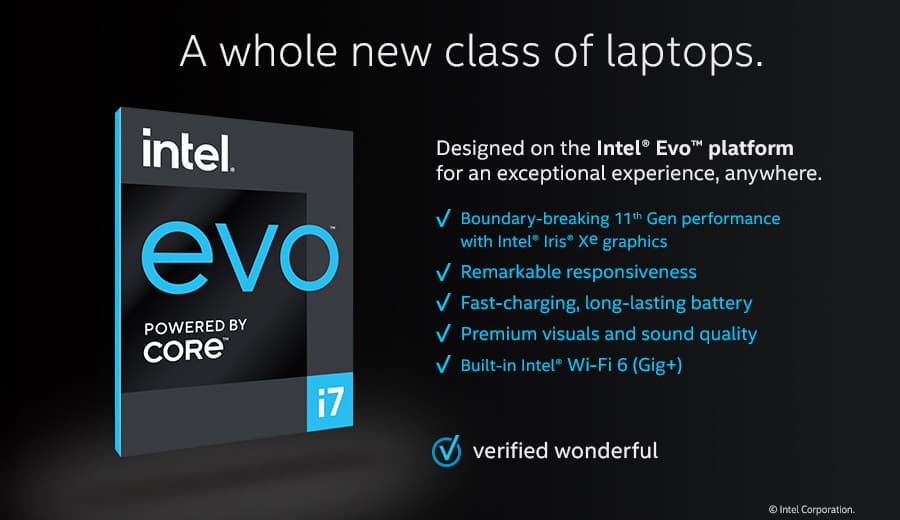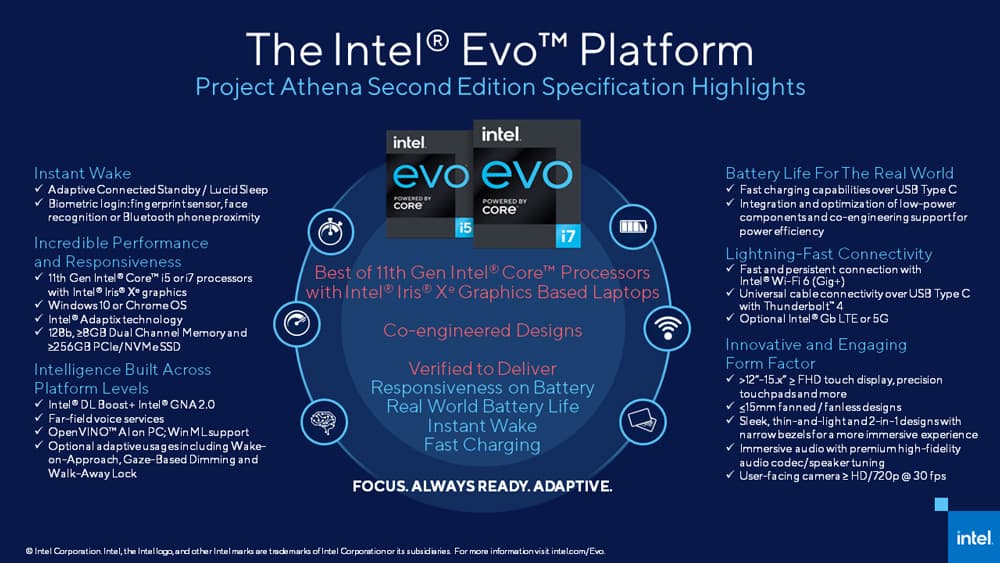 As a major manufacturer of CPU chipsets, Intel has considerable influence on the PC industry. They are using that influence to bring about a new standard in Intel-based PCs. You’ll start to see laptops with the new Intel Evo branding soon. So what does that mean? Here’s what you need to know about Intel Evo platform laptops.
As a major manufacturer of CPU chipsets, Intel has considerable influence on the PC industry. They are using that influence to bring about a new standard in Intel-based PCs. You’ll start to see laptops with the new Intel Evo branding soon. So what does that mean? Here’s what you need to know about Intel Evo platform laptops.
What is the Intel Evo platform?
 The Intel Evo platform is a comprehensive set of standards for performance and hardware configuration. The standard focuses on high powered, lightweight laptops, which are sometimes referred to as “ultrabooks”. So, manufacturers of high performance laptops will need to meet these standards in order to have their product designated as an Intel Evo laptop.
The Intel Evo platform is a comprehensive set of standards for performance and hardware configuration. The standard focuses on high powered, lightweight laptops, which are sometimes referred to as “ultrabooks”. So, manufacturers of high performance laptops will need to meet these standards in order to have their product designated as an Intel Evo laptop.
Why is the Intel Evo platform needed?
Your laptop can come in a variety of configurations and variations, based on who made it. This flexibility is also a drawback for consumers when it comes to consistency. You don’t know how one laptop compares to the other, other than comparing the technical specifications of each component. A standard like the Intel Evo will mean that any laptop with that designation will meet a common set of criteria.
Are Intel Evo laptops made by Intel?
I was a little confused by this at first. I assumed that a platform meant Intel was selling its own laptops. That is not the case. Though Intel supplies the CPU for any laptop with this designation, the devices will be built by the laptop manufacturers themselves.
What’s are the hardware standards for Evo laptops?
The foundation of the hardware requirements is an Intel 11th Gen. Core CPU (i5 or i7) with Intel Iris Xe graphics. Any Intel Evo laptop has to have at least 8GB of dual channel RAM and a solid state hard drive of 256GB or greater.
The form factor of the laptop is also a part of the platform. The screen must be at least 12”, with a thin bezel. And the laptop thickness can be no more than 15mm, to keep it as light and slim as possible. Also, Intel requires that any Intel Evo laptop has biometric login capability.
Evo standards based on real world use
The Intel Evo platform measures a laptop’s performance with key experience indicators (KEIs). As an example, an Intel Evo laptop needs to wake from sleep in less than a second. They need at least 9 hours of real world battery life, which means 9+ hours of battery under active use. Active use means that the laptop is running about 25 tasks at any given time, with many of them cloud-based companion apps like Twitter, Zoom or Spotify.
They also need Thunderbolt 4 and WIFI 6 connectivity to qualify. This makes sense, as data transfer speeds have definite performance impacts. If you don’t have enough bandwidth to stream and download, the power of your laptop’s CPU won’t have much of an effect.
For an example of an Evo laptop, check out the LG Gram 16 (the Guinness World Record holder as the lightest commercially available 16-inch laptop), which was reviewed in March.
The Intel Evo platform
 Hopefully, this post has given you a basic understanding of what the Intel Evo platform is, and how it will help you. The overall goal of the platform is to ensure that any laptop with that label can meet and exceed the performance expectations of the consumer. Consistent design makes for better product quality, and that benefits you, the buyer.
Hopefully, this post has given you a basic understanding of what the Intel Evo platform is, and how it will help you. The overall goal of the platform is to ensure that any laptop with that label can meet and exceed the performance expectations of the consumer. Consistent design makes for better product quality, and that benefits you, the buyer.



